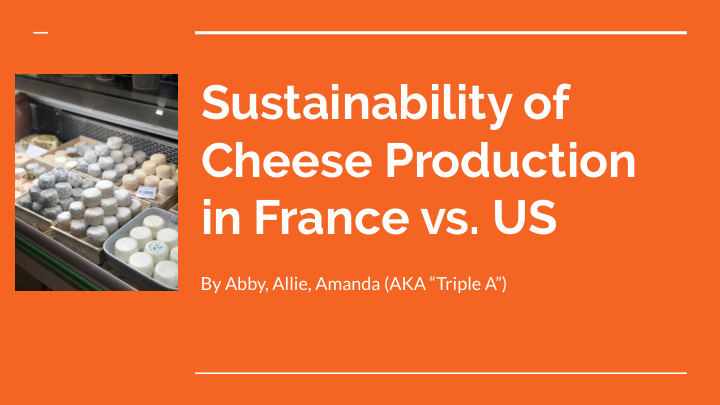



Sustainability of Cheese Production in France vs. US By Abby, Allie, Amanda (AKA “Triple A”)
Introduction Cheesemaking accidentally discovered by ● Egyptians, who salted curdled milk and added fruit juices 1 French value of artisanal cheese making process ● Contrast of US mass vs. local production ● Production, transformation, distribution, ● consumption and waste in US vs. France
Production France ● 38.3% grazed grass, 26.3% conserved grass, 19.4% silage corn, 5.4% ○ grain and 2.5% soy cake 2 Pasture fed during spring, summer and fall ○ Cereals and man-made food during winter ○ US ● At least 40% forage, such as hay, and at most 60% grain, such as ○ wheat or oats 2 May need more synthetic pesticides and complex waste ○ management systems
Transformation Cow, sheep or goat milk ● Raw milk cheese mildly heated to reduce harmful ● microorganisms, cooled to 90 ℉ Starter culture added to milk (ripening) which lowers pH ● and develops complex flavors Rennet is an enzyme that causes proteins to coagulate ● Curd ferments until pH is 6.4 ● Cheese heated until 100 ℉ which allows whey to separate ● from curd, whey drained off Curds formed into mat, either aged anywhere from 3 ● weeks to 24 months or prepared for distribution 3
Transformation Blue, hard, pasta filata, ● processed, semi-hard, semi-soft, soft, fresh and soft-ripened 4 Bacterial cultures (penicillin) ● can be added to create a spotted or veined pattern 4 Ash used to form a rind that ● contributes to aging process
Cheese Tasting Experiences Aging is determined by cheesemaker ● Supermarket (mass produced) bought more often and is ● pasteurized Cheese store (cheesemaker produced) favored but more ● costly and is not pasteurized Comet cheese most popular in France ● Use sheep, cow, goat milk ●
Distribution France ● $3.5 billion exported 5 , $1.7 billion imported 6 , $1.8 ○ billion net export in 2017 6th largest country to export cheese in world with ○ majority of exports going to US 7 Regional AOC label marks authenticity ○ US ● $1.5 billion exported 5 , $1.23 billion imported 6 , ○ $270 million net export in 2017 No national authenticity requirements ○
Consumption France: 25.9 kg of cheese per year 8 ● US: 15.4 kg of cheese per year 8 ● French Paradox: French eat more full-fat foods in ● comparison to Americans and their diet consists of higher amount of saturated fats yet they have lower cardiovascular mortality rate 9 Potassium, magnesium, calcium, phosphorus, vitamin D, B6 and ○ peptides in milk may lower blood pressure Higher amounts of butyric acid associated with lower risk of obesity ○ and can lead to faster metabolism
Consumption Estimates show that there are 400 cheese varieties, some ● would argue this number could be as high as 1,000 if sub-varieties are included Highest estimate of cheese varieties promoted “cheese ● maps of France”
Consumption There are several types of cheese that the French prefer 9 ● Soft cheese ○ Semi soft cheese ○ Hard cheese ○ Semi hard cheese ○ Goat cheeses ○
Brie- Soft Cheese (Cow Milk) Mimolette- Hard Cheese (Cow Milk) Portnenay (Blue Cheese from Goat) Soft Ossau: Semi-Hard Cheese (Sheep Milk) Cheese, Morbier: Semi-Soft Cheese (cow milk)
Waste and Sustainability France ● 0.03 tonnes, or 66 pounds, of food waste per person per year 10 ○ About 67 million person population ○ Supermarket food waste legislation ○ Edible rind replaces need for packaging ○ Small scale family farms may be inhibited by taxation and limited ○ vacation opportunities Machine washable plastic molds more efficient than clay pots ○ US ● 612 pounds of food waste per person per year 10 ○ About 300 million person population ○ Plastic or wax packaging for mass produced varieties ○ Large scale farms ○
Conclusion Cultural emphasis that France places on cheese ● influences bottom-up approach to sustainability throughout production, in comparison to US’s top-down approach, in hopes of preserving culinary artform for future generations Reflection ● What do you think of cheese making process in France versus US? ○ How do you think we can take what we learned in France and apply ○ it to the US?
Works Cited https://nationalhistoriccheesemakingcenter.org/history-of-cheese/ 1. 2. http://idele.fr/?eID=cmis_download&oID=workspace://SpacesStore/10b22a31-862e-440f-a0 79-c1710d964e72 3. http://www.milkfacts.info/Milk%20Processing/Cheese%20Production.htm 4. https://www.nationaldairycouncil.org/sitecore/content/dg/home/content/2016/cheese-types-w hat-you-need-to-know-about-cheese 5. http://www.worldstopexports.com/cheese-exports-country/ http://www.worldstopexports.com/cheese-imports-by-country/ 6. 7. https://atlas.media.mit.edu/en/profile/country/fra/ 8. http://www.lactimed.eu/en/France-cheese-consumption. 9. http://eda.euromilk.org/fileadmin/user_upload/Public_Documents/EDA_Position_papers_-_ Fact_Sheets/Fact_sheets/CNIEL-Questions_sur_les_produits_laitiers.pdf 10. https://www.npr.org/sections/thesalt/2018/02/24/586579455/french-food-waste-law-changin g-how-grocery-stores-approach-excess-food
Recommend
More recommend